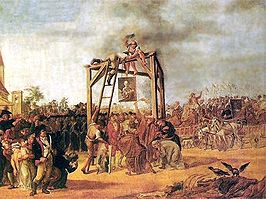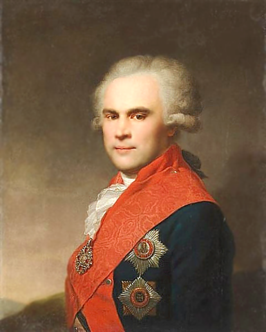- Targowica Confederation
-
 Hanging in effigy of the Leaders of Targowica Confederation, Warsaw, 1794, in the aftermath of the Warsaw Uprising (1794). Painting by Jan Piotr Norblin.
Hanging in effigy of the Leaders of Targowica Confederation, Warsaw, 1794, in the aftermath of the Warsaw Uprising (1794). Painting by Jan Piotr Norblin.
The Targowica Confederation (Polish: Konfederacja targowicka, IPA: [kɔnfɛdɛˈrat͡sja tarɡɔˈvit͡ska], Lithuanian: Targovicos konfederacija) was a confederation established by Polish and Lithuanian magnates on 27 April 1792, in Saint Petersburg, with the backing of the Russian Empress Catherine II.[1] The confederation opposed the Polish Constitution of May 3, 1791, which had been adopted by the Great Sejm, especially the provisions limiting the privileges of the nobility. The text of the founding act of the confederation was written by the Russian general Vasili Stepanovich Popov, Chief of Staff of Prince Grigori Alexandrovich Potemkin. Its purpose was proclaimed in the small town of Targowica (now in Kirovohrad Oblast, Ukraine) on May 14, 1792.[1] Four days later two Russian armies invaded the Polish-Lithuanian Commonwealth without a formal declaration of war.[1]
The forces of the Targowica Confederation defeated the forces loyal to the Polish-Lithuanian Commonwealth, the Sejm and King Stanisław August Poniatowski in the Polish–Russian War of 1792. As a result the King, Poniatowski, formally joined the Confederation. Their victory precipitated the Second Partition of Poland and set the stage for the Third Partition and the final dissolution of the Commonwealth in 1795.[2] This outcome came as a surprise to most of the Confederates, who had wished only to restore the status quo ante and had expected that the overthrow of the May 3rd Constitution would achieve that end.[1]
The nickname "targowiczanin", describing the supporters of this confederation, became a negative political epithet in Poland, akin to "foolish traitor", still used up to the modern day.[3]
Contents
Leading members
- Stanisław Szczęsny Potocki: Marshal (head) of the Confederation.[4] Sentenced to death, but never apprehended. Instead, on September 29, 1794, his portrait was hanged (see illustration). In 1795 he was rewarded by Catherine the Great with the Russian Order of Alexander Nevsky and the rank of Général en chef.
Other magnate members:
- Franciszek Ksawery Branicki:[4] Sentenced to death during the Kościuszko Uprising but never apprehended. Emigrated to Russia, died at Biała Cerkiew, 1819.
- Szymon Marcin Kossakowski: Hanged April 25, 1794, in Wilno during the Kościuszko Uprising.
- Józef Kazimierz Kossakowski: Bishop. Hanged May 9, 1794, in Warsaw during the Kościuszko Uprising.[5]
- Ignacy Jakub Massalski: Bishop. Hanged June 28, 1794, in Warsaw during the Kościuszko Uprising.[6]
- Seweryn Rzewuski.[4]
See also
- Hetman Party
Quotes
- From the Establishing Act of the Targowica Condeferation:[7]
"The desires of Her Highness Empress of Russia [Catherine the Great], ally of Rzeczpospolita [the Commonwealth], are and were no other than by using her armies to return to Rzeczpospolita and Poles the freedoms, and especially security and happiness to all citizens"
- One of the founders of the Targowica Confederation, Stanisław Szczęsny Potocki:
"Each true Pole, not blinded by the Prussian and royalist cabal, is convinced, that our Fatherland can only be saved by Russia, otherwise our nation will be enslaved".
- After Stanisław Poniatowski's abdication and the destruction of the Commonwealth, he said:
"About past Poland and Poles [I don't want to talk anymore]. Gone is this country, and this name, as many others have perished in the world's history. I am now a Russian forever."
References
- ^ a b c d Daniel Stone, The Polish-Lithuanian state, 1386-1795, University of Washington Press, 2001, pg. 282-285 [1]
- ^ Tanisha M. Fazal, "State death: the politics and geography of conquest, occupation, and annexation", Princeton University Press, 2007, pg. 108 [2]
- ^ Patrice M. Dabrowski, "Commemorations and the shaping of modern Poland", Indiana University Press, 2004, pg. 101, [3]
- ^ a b c Richard Butterwick, "Poland's Last King and English Culture", Oxford University Press, 1998, pg. 310, [4]
- ^ George J. Lerski, Jerzy Jan Lerski, Piotr Wróbel, "Historical dictionary of Poland, 966-1945", Greenwood Publishing Group, 1996, pg. 268, [5]
- ^ George J. Lerski, Jerzy Jan Lerski, Piotr Wróbel, "Historical dictionary of Poland, 966-1945", Greenwood Publishing Group, 1996, pg. 342, [6]
- ^ Balázs Trencsényi, Michal Kopeček, "Discourses of collective identity in Central and Southeast Europe (1770-1945): texts and commentaries", Central European University Press, 2006, pg. 284, [7]
Categories:- 1792 establishments
- Polish confederations
- Partitions of Poland
- 1792 in Lithuania
Wikimedia Foundation. 2010.

